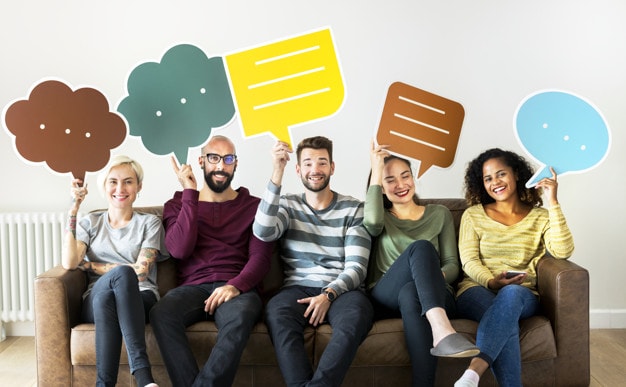What Does It Means Communication is Continuous
Communication is a way by which meaningful messages can be conveyed across people to convey ideas. Any kind of medium may be used by communication to convey the message.
What is Communication?
Communication is defined as the process of understanding and sharing meaning. Here, the process is any kind of activity that does not remain constant. It changes all the time and cannot be defined.
Therefore the concept of the process has a change in feedback, change in perspective, or any other relevant change which impacts the existing state of affairs. For example, when you travel to the office from home, your process changes because your perspective changes since you interact with a different set of people.
The next part of the definition of communication is understanding. Understanding means to comprehend or interpret. You will be able to understand a movie more clearly than merely watching non-moving pictures without explanation or sound.
The last part of the definition is sharing. When you do something together with one or more people, then it can be termed as sharing.
Thus communication is a culmination of all of these components to form a comprehensible, knowledgeable, and informational activity to convey information, messages, or any other relevant thoughts to a receiver or a group of receivers.
Importance of communication
Practically the world runs because of communication. The importance of communication cannot be stressed enough in our day to day's work. If it were not for communication, then we would be back in Neanderthal times.
Right from our home to our workplace, there is communication everywhere. From a song, speech to site head nod, or handshake, different forms of communication are used throughout the day without you realizing it. Communication makes conveying the thoughts easier and helps to understand the perspective of another person.
Learning would stop without communication since you cannot teach anyone without the use of text, pictures, sound, or sign language. There would be no exchange of ideas or thoughts without communication, and businesses would not be able to sustain, and neither could people.
Elements of Communication

It is essential to understand the vital components of communication to understand the process of communicating clearly.
Following are eight different components of communication
1. Source
The source is the creator of the message. The source initiates the message and sends it to the sender. A person talking to a group of people can be considered as a source of speech.
The source conveys the message with the help of verbal as well as non-verbal communication.
Sometimes written and visual types of communication may also be involved. The primary objective of the source is to convey the thoughts or ideas they have to the receiver.
2. Message
The actual context of communication is a message. The message is the formalized structure of communication. A group of pictures may be kept together to convey a story, or a couple of letters are put together to convey a message.
As explained above, the message's intention is dependent on not only the words of the message but also the tone, voice modulation, and manner in which the messages are conveyed to the other person.
Different elements come into play in various types of communication. For example, tone, voice modulation will matter in verbal communication, while the grammar and punctuation matter in written communication.
On the other hand, in the case of non-verbal communication, your gestures and body language matter while in the case of visual communication, the pictures, its settings, and visual quality will matter.
3. Channel
The method in which the messages are communicated from one point to the other is called a channel. Channels are essential to convey the message from the source to the destination.
If the message is not transmitted, then the desired action will not be taken, and the communication process will not be valid.
4. Receiver
The receiver is the one who receives the message from the sender. The receiver can be considered as the termination point of the communication process or originating source for the feedback process of the communication.
The receiver can see, feel, hear, touch, or appropriately analyze the message sent by the sender depending on the type of communication. Both the receiver and the sender must be on similar lines so they can understand the message because if the sender and receiver are not able to understand each other, then the entire purpose of the communication fails.
There could be many differences between the sender and receiver, and for optimum communication to happen, those differences should be as low as possible.
5. Feedback
After the receiver receives the message, the receiver comprehends the message. He tries to make meaning out of it and understand it. Once he understands, then the feedback is sent from the receiver to the sender. During this time, the receiver becomes the sender, and the sender becomes the receiver because feedback travels from receiver to sender.
The existence of feedback suggests that communication is a two-way process. As much as the sender wants to convey a message to the receiver, the receiver also wants to convey back message to the sender.
This feedback will be based on the message which is initially sent from the sender and will be sort of an answer to that message.
6. Environment
The atmosphere in which we receive the message is called an environment. The environment may include but is not limited to the surrounding equipment, objects, climate, and other things that are present when the process of communication happens.
The external surroundings in which we stand to talk to another person can also be termed as the environment.
A theatre packed with an audience can also be considered as the environment. Every environment may have some requirements for looks. For example, going to a party will have a dress code, while coming to an office with a formal dress code. In such cases, not only the dressing but also communication depends on the environment. It is essential to understand your environment before you start communicating.
7. Context
The context is where the setting or scene of communication takes place. For example, business discussions such as presentations take place in a group of people. Therefore the context for such a discussion is formal.
On the other hand, communication with family members is usually casual. Context is about how people expect you to be in specific settings. Typically environmental cues are used to create those expectations.
8. Interference
Interference is another term for noise that is present in the communication process. The primary function of noise is to block or create an obstacle in communication so that the intended message is either half reached or not reached at all to the receiver.
For example, if a baby cries in a theatre during the climax of a movie, your attention is disturbed. The intended message of the movie does not reach you. While this is an example of external noise, there is also an internal noise that is present in ourselves.
Thoughts that are occupied in your mind when you're doing work is called psychological noise. These thoughts interrupt your work more often than you can imagine. If not for these psychological interferences, all of us would have been productive at least ten times more than we are right now.
Another type of noise is when the message is communicated to you clearly, but your mind interprets it differently. For example, an invitation card says, "Black tie only." A significant interference would be detected in the person if he wore 'only' a black tie to the party.
Functions of Communication
Some of the common functions of communication are-
1. Informing
This function of communication is used for informing purposes. It comes into play for grabbing and sharing informative messages. You can use this function of communication verbally or non-verbally.
2. Regulating or Controlling
The second function of communication is used for regulating or controlling the behavior, inclinations, and feelings of the participants. The speaker or writer will regulate or control the activities of the listener by sharing verbal or nonverbal signals. Listeners can also control or regulate by giving some signals to control the way someone is interacting.
3. Social Interaction
With the help of this function of communication, social relationships build. Social interaction is used for forming bonds, relations, intimacy, or relations. It also helps in creating relationships with internal and external parties of an organization like employees, leaders, suppliers, investors, customers, etc.
4. Motivating or Persuading
One of the most common functions of communication is motivating, persuading, or influencing someone with your thought process. It is highly effective in business management as well, as managers and leaders have to have the communication skills to motivate their teams.
5. Reducing Misunderstanding
Communication plays one of the most crucial roles in reducing confusion, conflict, misunderstanding, and controversies. It overcomes all such sorts of issues and therefore, organizations have an upward and downward communication system for resolving different issues, controversies, and disagreements.
6. Decision/Choice Making
Communication is the backbone of effective decision-making processes in personal as well as professional lives. It channelizes information and viewpoints that empower the decision-making process. From management to leaders to lower-level employees, all use communication practices to participate in the decision-making process.
7. Solving Problems/Troubles
We face so many impediments, difficulties, and issues in our personal as well as professional world. Communication can come to our rescue so many times in our day-to-day activities. The right way of communicating issues with the associated or responsible person paves the path of finding best-suited solutions. It will also safeguard from any misinterpretation or bias when any issue arises.
Nature of Communication
A communication process may have the following nature
1. Two-way process
Communication revolves around a two-way process in which at least a sender and a receiver participate, as one individual will not be able to communicate with himself.
2. Verbal and non-verbal
One of the most important natures of communication is its ability to be verbal and nonverbal. In the verbal form of communication, words are used for sharing information while in nonverbal communication, body language, gestures, postures, etc are used for communicating.
3. Continuous process
The communication process comprises a continuous process that channelizes the exchange of ideas and opinions in an ongoing manner. The continuous interactions associated with the communication process are associated with discussion and decision making processes.
4. Goal-oriented
A communication session is considered successful when it helps associated participants accomplish the relevant goals. Therefore, goal orientation is one of the most important natures of effective communication.
5. A Medium, not an end
Communication works as a medium used for transferring information from one participant to another but it is not an end. So, communication act as a medium or means to reach toward the end for accomplishing goals.
6. Mutual understanding
Communication sets the ground for mutual understanding. Participants of a communication process develop a mutual understanding of the shared topic, subject, or message.
7. Dynamic process
The nature of communication is also dynamic, as it occurs between sender and receiver in various forms via different mediums as per the needs and inclinations of the communication. So, the process of communication keeps on changing in different situations which makes it dynamic.
8. Exchange
The nature of communication is based upon the idea of exchanging information, views, messages, thoughts, opinions, and feelings. Communication occurs when people engage with each other for developing understanding.
9. Pervasive
Communication is also ubiquitous as it is present everywhere. It takes place at different levels of professional, personal, or organizational structure.
10. Foundation of management
All the managerial functions are channelized through different means of communication. From making organizational plans and development, communication is the most crucial element that plays a significant role in managing different professional activities.
11. Inter-disciplinary
For effective communication, knowledge and information are derived from different fields and sciences such as anthropology (study of body language), psychology (study of attitude), sociology (study of human behavior), etc. By effectively using the information from these fields communication empowers itself and becomes more effective.
Video on Communication
Features of communication

1. Communication takes place between at least two or more people
The most important feature of communication is the parties involved in the communication process. The communication usually takes place between two or more than two people where one person is the recipient of the information, and another is the transmitter of the information.
However, a communication process is a two-way communication process, which means both parties involved in the communication process can share information at the same time.
2. A two-way process
As we have learned already that communication is a two-way process where all parties involved in the communication process exchange ideas and information with one another.
However, communication is not complete unless the message is not understood and acknowledged by the receiver of the message.
3. The message

Communication is useless if it does not contain a useful message. Therefore, a message is a must in the communication process. A message can be an idea, information, instructions, or suggestions.
A communication is called effective if it delivers the intended message properly, and there will be no communication with no message.
4. Dynamic in nature
Communication is dynamic, which means it grows and evolves with the participation of parties and their mood and state of mind involved in the communication.
Therefore, communication can either last for hours or last for just a few seconds depending on the information being shared in the communication and the interest of people involved in the communication.
For example, a meeting between the manager and his subordinates can last for 10 minutes or can also last for hours, depending on the discussion taking place in the meeting.
5. Establish mutual Understanding
Another important feature of communication is to establish understanding between the parties involved in the communication process which means the information is received and understood by the receiver in the same way as the sender wanted it to be received and understood.
Communication is not successful until the message is not conveyed correctly and until the acknowledgment is not received by the sender of the message.
6. Response

Communication will be considered complete only if the appropriate response is received by the sender of the message.
7. Systematic
Communication is systematic, which means each component of the communication depends on the other component of the communication. The meaning of entire communication will change with the little change in any of the component involved in the communication.
For example, if communication takes place between a boss and his subordinate over the phone. The information exchanged in the communication process can be affected by the slightest problem in the phone line.
8. Form of communication
Communication can take place in any form. For example, it can be oral, written, or in gestural form. Oral and written communication is considered as formal communication and is often used in a business environment. However, gestural communication takes place by conveying information using hands or eyes movements.
It is an informal type of communication which is widely used in the informal environment but is not acceptable and considered appropriate in the formal environment.
9. The flow of information

The communication can take place between superior, and his subordinates where information flows from upper level to lower level and vice versa and similarly communication can also take place between two persons working at the same level in an organization.
This type of communication is referred to as side-to-side communication. Both up-to-down and side-to-side communication can be both formal as well as informal in nature.
For example, when one employee share information mentioned in a circular with another employee is called formal communication and when the same employee shares a rumor about another employee working in the same organization is an example of informal communication.
10. A continuous Process
A communication process is a continuous process where information is shared between the people involved in the communication endlessly.
For example, a manager gives instructions to his subordinates to complete various jobs at work.
Role of Communication

A good leader knows all about the key role of communication.
They communicate well with the organization's members to make them more productive in due course of time. The following are the essential qualities of the effective communication that are mandatory for any organization:
1. Ensuring Clarity of Message Delivery
All effective communication methods are easy and straightforward. They are subtly clear and concise with the organization's work.
As a leader, you don't be vague about your messages and views. Communicate well and converse with full clarity to avoid any misconception. The goals should be set and clear in the mind of every person. The team leaders provide this clarity of goals.
What is the duration of the project? How long will it take to complete? Ask these questions clearly to make the right decisions about the project. Vague and incomplete communication leads to unproductive stages in the concerned organization.
2. Communication to establish personalization
To communicate with everyone in the room is a tedious task. But an effective leader knows that everyone is essential in the room and has a voice.
He or she makes a mental note of every employee present in the team for excellent and effective communication. Getting to know all employees at a personal level instills a different type of confidence in them. Through effective communication, these employees can deliver their thoughts directly to the leaders or managers.
The acknowledgment of every employee is vital for good communication.
3. Ensuring transparency in work
Transparency is an essential factor when it comes to executing effective communication. The leader should have transparency in every work he or she does for an organization. The fellow employees observe every work of the leader with no hindrance.
All employees can observe all working processes due to the leader's transparent feature.
The leaders don't have any hidden agenda. The employees don't have to read under the lines and are all transparent and specific.
The deprivation of transparency leads to uncertain situations in the organization. This causes distrust and anxiety within the organization.
4. Listening to everyone and feedback system
Communication is a two-way process that has two persons- the message delivering agent and listener. All information is listened to by the team leaders carefully.
They hold the perspective of each teammate in their process to achieve goals for the organization. Effective communication builds relationships among all fellow employees for better accuracy and conciseness.
Every great leader analyzes the message well before concluding any conclusion. They lay their emphasis on the analysis of the messages. All great leaders are accountable for every process they make it deliver.
If they make any mistake, they instantly rectify it before any considerable loss to the organization. They do so without any exaggerated drama and false humility.
5. Offering the ability to inspire
It is the most vital element of effective communication. In this, the influential leaders have to inspire their teammates to that level to perform exceptionally well.
The leaders have the vision of success that helps in acquiring the goal for the organization. It is all up to the leader to communicate and inspire all team members to do well.
All excellent communications stand out from the crowd in all terms. These types of communications make the organization more productive and profitable.
Advantages of Good Communication

Communication is an integral part of great leadership. It enhances all work of the organization very well. Let us see the main advantages of effective communication:
- It increases employees' efficiency. By communicating well within an organization, employees can perform more efficiently. They have all of the knowledge and information they need to accomplish their roles and responsibilities.
- It enhances the organization's business performance. Effective communication plays an essential role in improving an organization's business performance.
- Several efforts, such as public relations and marketing, rely on the communication process to get the message across to the customers.
- Through the process of communication, leaders can target the market. They can tell compelling stories about why their products and services should matter to their existing customers.
Conclusion
Therefore, communication is a vital aspect of our existence. Using appropriate communication in appropriate settings is essential for effective communication. This can be achieved by being mindful of different elements of communication.
erskineantiver1986.blogspot.com
Source: https://www.marketing91.com/what-is-communication/
0 Response to "What Does It Means Communication is Continuous"
Post a Comment